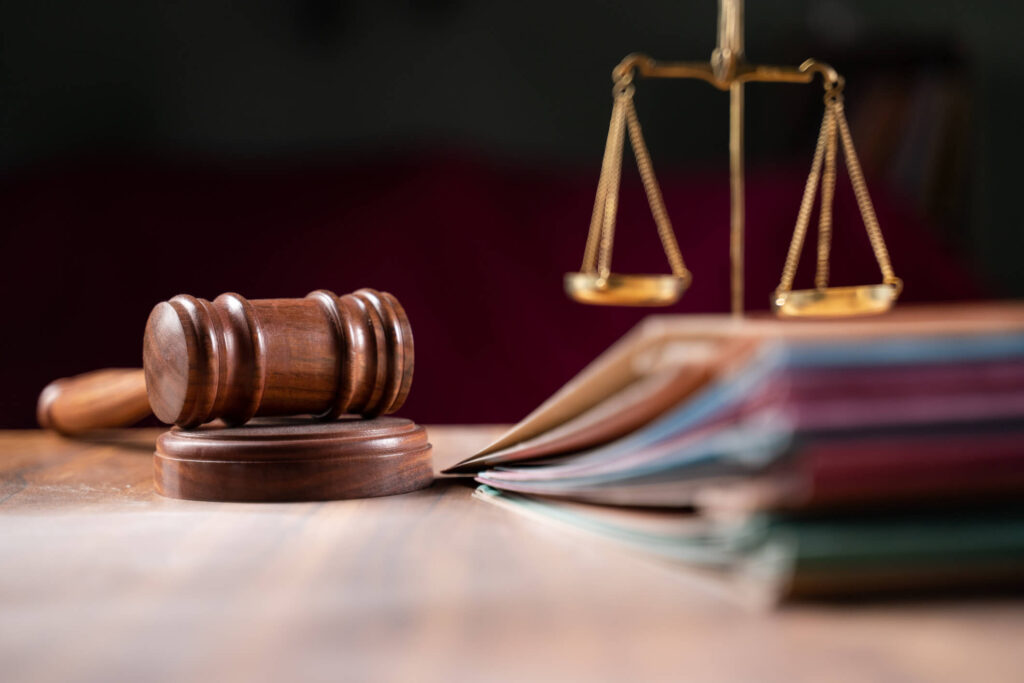Legal Considerations for E-Bike Accidents
E-Bike Accidents and Negligence

Most e-bike court cases relate to negligence. Negligence occurs when someone doesn’t do what they were supposed to do. This may seem simple to prove. However, in a court case, there are five elements that must be proven to find someone guilty of negligence.
1. Duty
As members of society, we all have a certain level of duty toward each other. For example, we all have the duty to obey traffic laws. For a case of negligence, the accused party must have had a duty to the plaintiff.
2. Breach of Duty
For there to be negligence, this duty described above must have been breached; this means that someone did not do their expected duty. For instance, when someone fails to yield to a pedestrian in a crosswalk, the driver has breached the duty of obeying traffic laws.
3. Cause in Fact
The plaintiff in a case must prove that their damages (physical injuries, property damage, economic losses, etc.) were the direct result of the defendant’s breach of duty. In other words, the damages were not caused by anything else, and wouldn’t have happened at all if the defendant hadn’t committed the breach.
4. Proximate Cause
Determining that damages were caused directly by the breach of duty is not enough to conclude a negligence case. The person who committed the breach must also have been able to “foresee” that damage could have occurred. For example, when someone drives far over the speed limit, they know that this behavior could cause injury or damage to others. If the damage incurred could not possibly have been expected, the defendant might not be charged with negligence.
5. Damage
Even when all of the above elements are present, if no actual damage has occurred, then there is no case for negligence. There must be actual damages, usually in the form of physical injury or property damage. If, for example, a car recklessly cut off an e-bike rider, but no accident occurred and the rider was unharmed, there is no case for negligence.
Stay Informed: Essential Laws for Avoiding E-Bike Accidents

Many of the traffic laws that drivers follow are similar for bicyclists, including e-bike riders. Below is a list of traffic laws that could be related to e-bike accidents. It is not an exhaustive list. For more specific information, see the California Driver’s Handbook, or the DMV driver handbook specific to your state.
Drivers have the responsibility to:
- Look carefully before opening their car door when parked; if a bicyclist is riding past the car, they may be injured by running into the car door.
- Give bicyclists at least three feet of space when driving past them.
- Not drive in a bike lane, unless it is legally allowed for parking or making a right turn near an intersection. When this is the case, enter the bike lane carefully.
- Look for bicyclists and pedestrians before making legal right or left turns, or changing lanes.
- Follow all usual traffic laws, such as stopping at red lights and stop signs, and obeying the speed limit.
- Be aware of surroundings and free from distractions, such as texting or reaching for something in the back seat.
- Not be under the influence of drugs or alcohol.
E-bike riders have the responsibility to:
- Keep their e-bike in safe working condition by performing any required maintenance. For example, it is illegal to ride a bicycle without fully functional brakes.
- Follow the rules of the road that a regular car or bicycle must follow. This includes riding in the same direction as traffic, stopping at red lights and stop signs, signaling to switch lanes, following speed limits, and yielding to pedestrians in crosswalks.
- Stay visible to cars and pedestrians; for example, avoid weaving between parked cars.
- Have a light and reflectors when riding in the dark.
- Wear a helmet if under the age of 18.
- Not ride on sidewalks, unless it is allowed by the city.
- Ride as far to the right as possible in the bike lane.
- Be aware of surroundings and free from distractions, such as texting or wearing headphones in both ears.
- Not be under the influence of drugs or alcohol.
Factors Considered in a Legal Case Involving an E-Bike

Courts may consider a number of different aspects when determining how to rule on an e-bike accident case, including the following:
- The behavior of a vehicle driver. Was the driver distracted? Did the driver break a traffic law or drive recklessly?
- The behavior of a pedestrian. Did the pedestrian look for vehicles, including bicycles, before stepping into the street?
- The behavior of the e-bike rider. Did the rider follow traffic laws? Was the rider distracted or reckless? Did the rider have proper safety gear, such as a helmet, reflectors, or a light?
- The condition of the road. Was the bike lane large enough for the safe travel of the bicyclist? Was the road well-kept, or did it have potholes, debris, or other defects that could endanger someone on an e-bike?
- The condition of the e-bike itself. Were there any defects in the manufacturing of the e-bike? Did the rider keep the e-bike in good condition?
This means that an e-bike rider may sue a driver or pedestrian, a manufacturer, a city or other public entity which is in charge of infrastructure, or even another bicyclist. However, the e-bike rider may be found partially or fully responsible for the accident as well.
What Do I Do If I've Been in an E-Bike Accident?

Often, there are many complex aspects to an e-bike accident case, which makes it difficult to prove fault or negligence. If you or a loved one has been involved or injured in such an accident, this is the last thing you want to be worrying about. Your first step is to contact a lawyer who can help you navigate the difficult intricacies of your case. An attorney can help you get compensation for injuries sustained, pain and suffering, property damage, work hours lost due to injuries, and sometimes even emotional distress.
If you or someone you know has been in an e-bike accident, we want to help you find justice. Please contact us to schedule a free consultation, during which we can listen to the details of your accident and injuries, and determine whether you have a solid legal case.
Do you have questions?
Please contact us to schedule a consultation:
Frank J. Coughlin, Esq.
Frank J. Coughlin, Prof. Law Corp.
17853 Santiago Blvd., 107-353 Villa Park, CA 92861
Phone: (714) 558 – 7886
Email: fjcoughlin@fjclaw.com
Website: https://www.fjclaw.com
E-Bike Accidents and Negligence
Most e-bike court cases relate to negligence. Negligence occurs when someone doesn’t do what they were supposed to do. This may seem simple to prove. However, in a court case, there are five elements that must be proven to find someone guilty of negligence.
1. Duty
As members of society, we all have a certain level of duty toward each other. For example, we all have the duty to obey traffic laws. For a case of negligence, the accused party must have had a duty to the plaintiff.
2. Breach of Duty
For there to be negligence, this duty described above must have been breached; this means that someone did not do their expected duty. For instance, when someone fails to yield to a pedestrian in a crosswalk, the driver has breached the duty of obeying traffic laws.
3. Cause in Fact
The plaintiff in a case must prove that their damages (physical injuries, property damage, economic losses, etc.) were the direct result of the defendant’s breach of duty. In other words, the damages were not caused by anything else, and wouldn’t have happened at all if the defendant hadn’t committed the breach.
4. Proximate Cause
Determining that damages were caused directly by the breach of duty is not enough to conclude a negligence case. The person who committed the breach must also have been able to “foresee” that damage could have occurred. For example, when someone drives far over the speed limit, they know that this behavior could cause injury or damage to others. If the damage incurred could not possibly have been expected, the defendant might not be charged with negligence.
5. Damage
Even when all of the above elements are present, if no actual damage has occurred, then there is no case for negligence. There must be actual damages, usually in the form of physical injury or property damage. If, for example, a car recklessly cut off an e-bike rider, but no accident occurred and the rider was unharmed, there is no case for negligence.
Stay Informed: Essential Laws for Avoiding E-Bike Accidents
Many of the traffic laws that drivers follow are similar for bicyclists, including e-bike riders. Below is a list of traffic laws that could be related to e-bike accidents. It is not an exhaustive list. For more specific information, see the California Driver’s Handbook, or the DMV driver handbook specific to your state.
Drivers have the responsibility to:
- Look carefully before opening their car door when parked; if a bicyclist is riding past the car, they may be injured by running into the car door.
- Give bicyclists at least three feet of space when driving past them.
- Not drive in a bike lane, unless it is legally allowed for parking or making a right turn near an intersection. When this is the case, enter the bike lane carefully.
- Look for bicyclists and pedestrians before making legal right or left turns, or changing lanes.
- Follow all usual traffic laws, such as stopping at red lights and stop signs, and obeying the speed limit.
- Be aware of surroundings and free from distractions, such as texting or reaching for something in the back seat.
- Not be under the influence of drugs or alcohol.
E-bike riders have the responsibility to:
- Keep their e-bike in safe working condition by performing any required maintenance. For example, it is illegal to ride a bicycle without fully functional brakes.
- Follow the rules of the road that a regular car or bicycle must follow. This includes riding in the same direction as traffic, stopping at red lights and stop signs, signaling to switch lanes, following speed limits, and yielding to pedestrians in crosswalks.
- Stay visible to cars and pedestrians; for example, avoid weaving between parked cars.
- Have a light and reflectors when riding in the dark.
- Wear a helmet if under the age of 18.
- Not ride on sidewalks, unless it is allowed by the city.
- Ride as far to the right as possible in the bike lane.
- Be aware of surroundings and free from distractions, such as texting or wearing headphones in both ears.
- Not be under the influence of drugs or alcohol.
Factors Considered in a Legal Case Involving an E-Bike
Courts may consider a number of different aspects when determining how to rule on an e-bike accident case, including the following:
- The behavior of a vehicle driver. Was the driver distracted? Did the driver break a traffic law or drive recklessly?
- The behavior of a pedestrian. Did the pedestrian look for vehicles, including bicycles, before stepping into the street?
- The behavior of the e-bike rider. Did the rider follow traffic laws? Was the rider distracted or reckless? Did the rider have proper safety gear, such as a helmet, reflectors, or a light?
- The condition of the road. Was the bike lane large enough for the safe travel of the bicyclist? Was the road well-kept, or did it have potholes, debris, or other defects that could endanger someone on an e-bike?
- The condition of the e-bike itself. Were there any defects in the manufacturing of the e-bike? Did the rider keep the e-bike in good condition?
This means that an e-bike rider may sue a driver or pedestrian, a manufacturer, a city or other public entity which is in charge of infrastructure, or even another bicyclist. However, the e-bike rider may be found partially or fully responsible for the accident as well.
What Do I Do If I’ve Been in an E-Bike Accident?
Often, there are many complex aspects to an e-bike accident case, which makes it difficult to prove fault or negligence. If you or a loved one has been involved or injured in such an accident, this is the last thing you want to be worrying about. Your first step is to contact a lawyer who can help you navigate the difficult intricacies of your case. An attorney can help you get compensation for injuries sustained, pain and suffering, property damage, work hours lost due to injuries, and sometimes even emotional distress.
If you or someone you know has been in an e-bike accident, we want to help you find justice. Please contact us to schedule a free consultation, during which we can listen to the details of your accident and injuries, and determine whether you have a solid legal case.